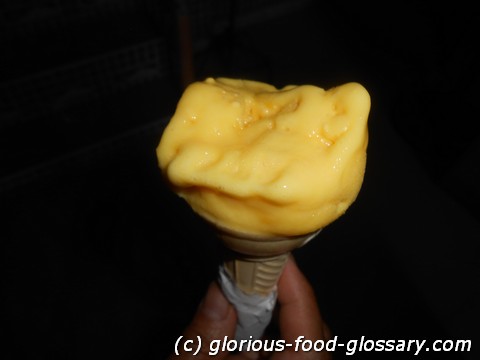Deutsch: Dirty Ice Cream / Español: Helado Sucio / Português: Sorvete Sujo / Français: Glace Sale / Italiano: Gelato Sporco
Dirty Ice Cream in the food context refers to a colloquial term used in the Philippines to describe homemade or street-vendor ice cream, not because it is unclean, but because it is made in a less controlled environment compared to commercial ice cream. Despite its name, dirty ice cream is a popular treat among locals and tourists alike, known for its unique flavors, creamy texture, and the traditional way it is served from colorful pushcarts along streets and at local events.
Description
Dirty Ice Cream is characteristically made from coconut milk or carabao's milk, setting it apart from the more common dairy milk-based ice creams. It comes in a variety of local flavors such as ube (purple yam), Mango, pandan, cheese, and buko (young coconut), among others. This type of ice cream is often served in small wafer cones, cups, or sandwiched between slices of pandesal (a Filipino bread roll) or in a traditional Filipino wafer called "barquillos."
Application Areas
Dirty Ice Cream is primarily consumed as a:
- Street Food: It's a common sight in Philippine streets, served from vibrantly decorated carts.
- Dessert: Enjoyed after meals or as a snack during hot days.
- Event Treat: Often present at birthday parties, fiestas, and other local celebrations.
Well-Known Examples
Among the variety of flavors available, some well-known examples of dirty ice cream include:
- Ube: Made from purple yam, offering a distinct purple color and sweet, earthy flavor.
- Mango: Utilizes the Philippines' abundant mangoes for a fresh, tropical taste.
- Cheese: A unique flavor that combines the creamy texture of ice cream with the savory taste of cheese.
Recipes
While making Dirty Ice Cream at home may not replicate the exact experience of buying it from a street vendor, a basic recipe can give you a taste of this Filipino treat:
-
Preparation:
- Combine the milk, sugar, and salt in a saucepan and cook over low heat until the sugar dissolves.
- Add your chosen flavoring and mix well.
- Pour the mixture into an ice cream maker and churn according to the manufacturer's instructions.
- Transfer to an airtight container and freeze until firm.
- Serve in a small cone, cup, or sandwiched between pandesal or barquillos.
Treatment and Risks
While Dirty Ice Cream is enjoyed by many, it's important to consume it from reputable vendors to ensure food safety. Like any ice cream, it should be consumed in moderation due to its sugar and fat content, especially by those with dietary restrictions.
Similar Terms or Synonyms
- Sorbetes (the formal Filipino term for this type of ice cream)
Summary
Dirty Ice Cream, known as Sorbetes in the Philippines, is a beloved homemade or street-vendor ice cream celebrated for its coconut or carabao's milk base and array of unique local flavors. Despite its misleading name, it is a delightful part of Filipino culinary culture, cherished for its creamy texture and the joy it brings to streets, events, and households across the country.
--

Related Articles to the term 'Dirty Ice Cream' | |
| 'Sorbete' | ■■■■■■■■■■ |
| Sorbete in the food context refers to a traditional type of Filipino ice cream, distinctively known for . . . Read More | |
| 'Huckle Berry Ice Cream' | ■■■■■■■■■ |
| Huckle Berry Ice Cream: Huckleberry Ice Cream in the food context refers to ice cream flavored with huckleberries, . . . Read More | |
| 'Carbonara' | ■■■■■■■ |
| Carbonara in the food context refers to a traditional Italian pasta dish originating from Rome, made . . . Read More | |
| 'Isaw' | ■■■■■■■ |
| Isaw in the food context refers to a popular Filipino street food made from skewered and grilled chicken . . . Read More | |
| 'Maruya' | ■■■■■■■ |
| Maruya is a traditional Filipino snack made from bananas, typically Saba bananas, which are battered . . . Read More | |
| 'Soft Ice Cream' | ■■■■■■ |
| Soft Ice Cream, also known simply as soft serve, is a type of ice cream that is softer than regular ice . . . Read More | |
| 'Karinderia' | ■■■■■■ |
| Karinderia is a Filipino term used to describe small, local eateries or food stalls that serve a variety . . . Read More | |
| 'Samalamig' | ■■■■■■ |
| Samalamig refers to a variety of traditional Filipino cold drinks and refreshments, typically served . . . Read More | |
| 'Bituka' | ■■■■■■ |
| Bituka refers to the intestines of animals, particularly pigs and chickens, which are commonly used as . . . Read More | |
| 'Cream' | ■■■■■ |
| Cream is a dairy product composed of the higher-fat layer skimmed from the top of milk before homogenization. . . . Read More | |
